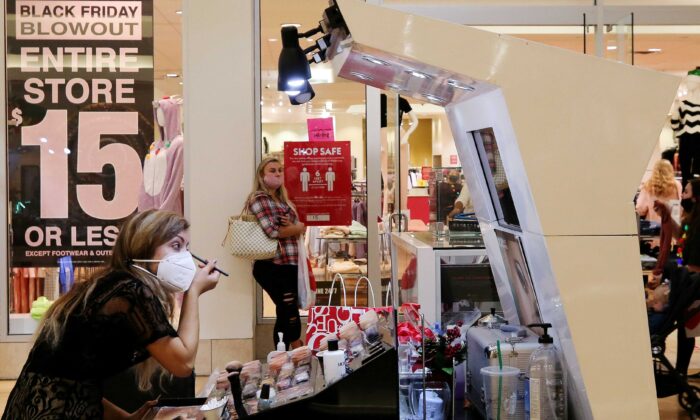
WASHINGTON—The U.S. economy grew at a record pace in the third quarter, fueled by more than $3 trillion in pandemic relief, the government confirmed on Dec. 22, but appears to have lost momentum as the year draws to an end amid raging new COVID-19 cases and dwindling fiscal stimulus.
The economy plunged into recession in February and remains 3.4 percent below its level at the end of 2019. The United States is struggling with a resurgence in new coronavirus cases, with more than 17.78 million people infected and over 317,800 dead, according to a Reuters tally of official data.
State and local governments have reimposed restrictions on businesses, undercutting consumer spending and unleashing a fresh wave of layoffs. The grim situation has been worsened by Congress’ delay in providing additional fiscal relief for struggling businesses and the unemployed.
“A few tenths more growth in the third quarter won’t be nearly enough with the shutdowns and restrictions from COVID-19 likely to take a heavy toll on the economy this winter,” said Chris Rupkey, chief economist at MUFG in New York. “The only good news is that corporate profits are rebounding more quickly than expected … more profits mean that companies will not have to lay off as many workers.”
Gross domestic product rebounded at a 33.4 percent annualized rate last quarter, the Commerce Department said in its third estimate of GDP. That was revised slightly up from the 33.1 percent pace reported last month and reflected more robust consumer and business spending than previously estimated.
The economy contracted at a 31.4 percent rate in the April-June quarter, the deepest since the government started keeping records in 1947. Economists polled by Reuters had expected third-quarter GDP would be unrevised at a 33.1 percent rate.
Twenty-one industries, led by the automobile sector, contributed to GDP growth last quarter. Mining was the only drag, likely because cheaper oil weighed on businesses spending on residential structures such as gas and oil well drilling.
Congress on Dec. 21 approved a rescue package worth almost $900 billion, which will see direct payments made to most Americans and provide enhanced payments to unemployed people. It will expand a small-business lending program and steer money to schools, airlines, transit systems, and vaccine distribution.
Though the additional stimulus will provide some cushion, economists said it was insufficient and a bit too late, noting that the package excluded aid for states and locals governments, whose budgets have been squeezed by the pandemic.
“The short-term nature of this relief underscores the need for a further relief package in the new Congress, since it is clearly not enough to sustain either the unemployed or small businesses until the pandemic winds down,” said David Kelly, chief global strategist at JPMorgan Funds in New York.
“The lack of further relief for state and local governments increases the likelihood of further layoffs in this sector in the months ahead.”
U.S. financial markets were little moved by the data.
Strong Profit Growth
After-tax profits without inventory valuation and capital consumption adjustment, which corresponds to S&P 500 profits, rebounded at a 36.1 percent rate in the third quarter, revised down slightly from the 36.6 percent pace estimated last month.
When measured from the income side, the economy grew at a 25.8 percent rate in the last quarter, rather than the 25.5 percent pace estimated in November. Gross domestic income (GDI) contracted at a rate of 32.6 percent in the second quarter.
The average of GDP and GDI, also referred to as gross domestic output and considered a better measure of economic activity, increased at a 29.6 percent rate in the July-September period. That was revised slightly up from the previously reported 29.2 percent pace and followed a 32.0 percent rate of decline in the second quarter.
While vaccines are being rolled out, health experts have warned it could take a while to achieve herd immunity.
Consumer spending, which accounts for more than two-thirds of U.S. economic activity, led the broad recovery last quarter, accelerating at a 41.0 percent rate, rather than the previously estimated 40.6 percent pace.
But consumption appears to have since cooled, with retail sales declining in October and November as household incomes came under pressure amid the expiration of a government-funded weekly unemployment subsidy.
First-time applications for weekly unemployment benefits are at a three-month high. Labor market stress and depleted household income have led to GDP growth estimates for the fourth quarter of around a 5 percent rate. Most economists expect modest growth or even a contraction in the first three months of 2021.
Business spending was revised up to a 22.9 percent rate in the third quarter from the previously reported 21.8 percent pace, because of robust investment in equipment. But business spending on nonresidential structures contracted for a fourth straight quarter.
By Lucia Mutikani
Focus News: US Third-Quarter GDP Growth Revised Slightly Higher; Momentum Waning